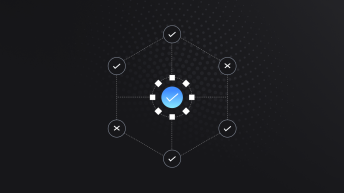This article forms the second part of the insightful conversation between Stuart (AKA the Wordsmith) and Alessio Treglia, the new Chief Technology Officer (CTO) at Jur. In this second half of the interview, the pair go into detail about the world of governance applications and Alessio’s vision for how he can help lead the company into its new bold era to create the building blocks for decentralised governance. If you missed the first exciting part, we encourage you to read it here.
As the conversation continued Alessio began to dig into how decentralised start-up societies and network states could evolve to help improve our current societal systems. He highlighted the fact that everything, including the Web3 world, is embedded in governance – even if many don’t realise it, stating how, “Web3 promises to revolutionise the financial system. However, even the systems of Web3 are governed through regulation. Governance is everywhere.”
Alessio continued to elaborate that the fundamental structure of our financial system and economy form the base of our society. Therefore, the way we want to trade with each other is based on rules, and as such governance helps us trade fairly. The CTO then explained how he believes governance lies at the heart of every organisation – it allows individuals, organisations and countries alike to come together and write the rules when a common interest is at stake. The conversation continued to highlight the importance and virtue behind governance, often helping rivals to reach common ground. “We want to write the rules so even rivals can sit down and agree on a basis for fair trade,” he said. “At the heart of governance lies a solid foundation for transparency and shared values.” Alessio’s wise words highlighted the widespread positive application that systems such as Network States can provide if implemented well – ensuring fair arbitration for almost any dispute or issue, as well as the discovery of common ground.
The pair continued on to discuss how there are many areas where one could focus and solve a particular problem in the public expenditure scenario using effective governance, given the fact that – as Alessio explained – across the world, 40% of the GDP is usually managed by a centralised government for public expenditure. Governance in that sense gives the public certain guarantees they need, and encourages them to take part in the democratic process perpetually. The conversation then expanded on this detail further through the example of Public Goods. Alessio explained how, “making money as a public good is not easy. They are deemed to be used as a right [by citizens]. They feel entitled to use it as a right. For example, public infrastructure, such as roads and highways, are used by everybody. However, there is always a business behind that.” As such governance of these public goods is crucial to maintain a cohesive and supportive society and can help circumvent issues by providing effective compromise solutions in a way that is agreed upon by all –such as paying highway tolls.
Stuart then started to dig deeper into Jur’s mission to build the infrastructure for Network States, starting by helping viewers understand what one is in its simplest form. Although the fundamental concept is not often easily understood at this stage of its infancy, Alessio had the perfect explanation. He began by drawing similarities between a Decentralised Autonomous Organisation (DAO) – which is a largely understood system in the Web3 space, explaining how, “the answer is very simple. A DAO is a subset of a Network State. [It is] an organisation of individuals and entities, all with some common interest – usually financial – who congregate…to pool resources together.” A DAO effectively helps a group of individuals to make decisions together through a decentralised democratic process on the blockchain. Alessio further expanded on this by stating, “[In a DAO] you bring capital to the party. You put capital at risk and then become a member of that DAO.” A Network State therefore is a superset of this use case that doesn’t rely solely on capital risk. The CTO concluded the explanation brilliantly by drawing parallels to members of a country. “[You are] a citizen…not because of the capital you possess, but for other reasons. You can be poor, but you would still be considered a citizen, and a potentially valuable one. The concept of a state is not a membership and is not dependent on capital,” which is exactly what a Network State is – a social community with an aligned mission for collective actions that operate through an on-chain social contract without requiring a physical territory.
With the definition of a Network State solidified, the conversation then shifted to the aspirations for Web3 ecosystems and how Jur will make a significant contribution to its growth and development. Alessio explained how Jur has already been playing a crucial role in the ecosystem in terms of building the technology and infrastructure for Network States as they continue to gather more use cases on a daily basis. “We don’t contribute by lending our expertise or experience,” he said. “Instead, we create building blocks and then create use cases on top of those blocks.” Indeed Jur prides itself on creating connections and asking the exact question that Alessio outlined: “What is the big problem for organisations and corporations in terms of governance?” and then assisting those seeking the technology required to structure their organisation in an efficient manner.
Stuart then wrapped up the engaging conversation by posing the new CTO a key question: “With your experience in building tech infrastructure and governance, what are your plans for decentralised governance?” Alessio responded by stating, “We [Jur] have new use cases coming to us on a daily basis, and the more use cases we have – the better equipped we are.” Again the response showed how Alessio has his finger on the pulse of Jur’s ethos. Building a constant influx of new use cases is crucial in growing the project’s knowledge in the space in regards to what organisations need, allowing it to by extension grow its toolbox and scale faster.
Overall, the fun and insightful conversation revealed a lot not only about the CTO’s past, but also its future vision – particularly as it continues to unveil the infrastructure for Network States and provide burgeoning organizations with better choices and support, using innovative blockchain technology.
Alessio concluded by stating, “Our vision is to empower people and societies to have a governance system come to [system-based] conclusions on-chain by leveraging our comprehensive tools. Although you can’t predict what democracy 2.0 or 3.0 will look like, you can start building the blocks to create it.”
And that is exactly what Jur intends to do as it gives power back to the people.




